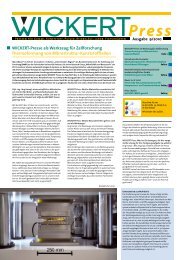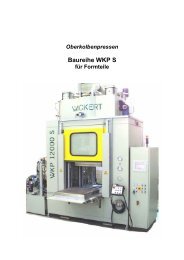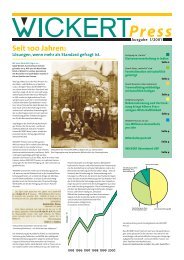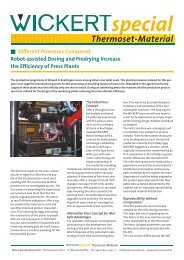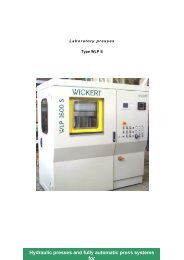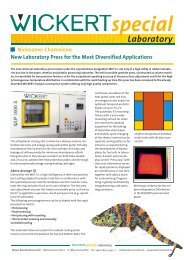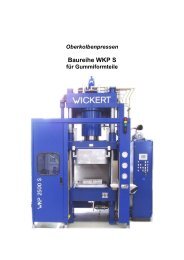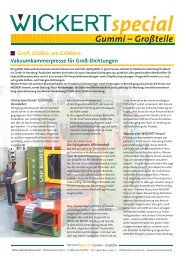WICKERT Special New Tecnologies Mikroengineering
WICKERT Special New Tecnologies Mikroengineering
WICKERT Special New Tecnologies Mikroengineering
Create successful ePaper yourself
Turn your PDF publications into a flip-book with our unique Google optimized e-Paper software.
special<br />
<strong>New</strong> Technologies/Microengineering<br />
Hot-stamping Plant for Microstructures<br />
The hot-stamping plant of the Type Stamp Press MS1 has been conceived for hot-stamping of microstructures into plastics. The forming<br />
of plastics by the hot-stamping process has proved its merits in microengineering and offers contrary to injection moulding a reduced<br />
material flow of the material during shaping, while simultaneous considerably less material mass has to be transported. During injection<br />
moulding plastizised material has to be injected into the mould while hot-stamping presses the microstructurized shape in plasticised<br />
material or plastic foils.<br />
special: <strong>New</strong> Technologies/Microengineering<br />
Essential for hot-stamping of microstructures<br />
are punches (mould elements) with<br />
super-fine structures and highly precise<br />
stamping machines. High-quality microcomponents<br />
can only be produced if<br />
these conditions are given.<br />
Extreme guidance accuracy<br />
The stamping machine offers an extraordinary<br />
guidance accuracy of the lockingstamping<br />
system as well as a precise<br />
servo-electric or servo-hydraulic drive.<br />
A force-travel control for the servo-axes<br />
warrants conformity with the required<br />
parameters during the stamping process.<br />
The axes can be moved with the<br />
most minute space of approximately 1 m<br />
during the stamping process. Heatingcooling<br />
cycles for the bottom and top<br />
stamping process. Heating-cooling cycles<br />
for the bottom and top stamping tools<br />
enable a most sensitive temperature control<br />
during the shaping.<br />
A special feature ensures the shaping of<br />
structures under the exclusion of trapped<br />
air. Additional ejectors of the machine<br />
provide for a gentle removal of workpieces.<br />
This stamping plant has proved it<br />
excellent utility on many occasions and<br />
can be tailored to a special requirements<br />
or modified to meet specified tasks.<br />
Wickert Maschinenbau GmbH · Wollmesheimer Höhe 2 · D-76829 Landau/Pfalz · Tel. ++49 (0) 63 41 -93 43 - 0 · info@wickert-presstech.de · www.wickert-presstech.de
Wickert Laboratory Press as Tool for Fuel Cell Development<br />
The Daimler-Benz AG is ceaselessly engaged in the exploration of new vehicle drives. One of the major target in this field is the fuel cell<br />
technology. In the estimation of experts the first of these fuel cell powered vehicle will appear in five to ten years on the market, such<br />
fuel cells for motor vehicles will be based on plastics foils of a precisely defined wall thickness of but a few millimetres.<br />
Specifically conceived for the production<br />
of these plastic elements is a fully<br />
hydraulic Wickert laboratory press with<br />
precision hot plates. A ramp function<br />
being provided for the heat plate temperatures<br />
and the pressforce. The press<br />
with a pressforce of 3 to 360 kN and a<br />
pressing surface of 400 x 400 mm is outstanding<br />
for the ingenious solution of the<br />
heating and cooling system. Resorted are<br />
precision hot plates ensuring a uniform<br />
temperature distribution over the entire<br />
surface. A temperature tolerance of max.<br />
+/- 1°C can by electrical heating be provided,<br />
thus ensuring the workpiece being<br />
uniformly heated over its entire surface.<br />
Highest demand is claimed for the planeparallelity<br />
of the workpieces. Flexibility of<br />
the press frame and pressure plates could<br />
be optimated by resorting to the finite<br />
element system. The result: The Wickert<br />
Laboratory Presses achieve a deviation<br />
of plane parallelity of less than 0.1 mm<br />
measured between the heat plates as<br />
full power and thus meet the highest<br />
demands.<br />
This high demand for precision applies<br />
also for the pressure initiation and halting.<br />
During hot pressing and also during<br />
the cooling procedure +1 % shall not be<br />
exceeded over the entire pressing range.<br />
For stabilization of the pressed stock and<br />
the subsequent unloading. Workpieces<br />
have to be cooled after hot pressing.<br />
Commonly heat plates are for this purpose<br />
cooled with water and reheated for<br />
the next cycle. At a stamp temperature<br />
of approx. 170°C and a<br />
removal temperature<br />
of approx. 40°C energy<br />
is at a considerable<br />
degree being wasted<br />
during this process. The<br />
energy waste could be<br />
curtailed for Wickert<br />
Laboratory Presses.<br />
In these presses the<br />
moulded parts are in<br />
a hot condition placed<br />
on a tray after opening<br />
of the press automatically.<br />
Inserted from the<br />
rear are separated cooling<br />
plates covering the<br />
moulded part from top<br />
and bottom. During<br />
closing of the press for<br />
cooling of the workpiece<br />
the heat plate is<br />
special: <strong>New</strong> Technologies/Microengineering<br />
thermally separated from the cooling plate<br />
by isolating plates. Heating plates are<br />
thus only slightly cooled down and the<br />
energy loss is, compared to those of conventional<br />
cooling procedures, drastically<br />
reduced. Cooling plates being inserted<br />
and removed by a mechanical system.<br />
Wickert Maschinenbau GmbH · Wollmesheimer Höhe 2 · D-76829 Landau/Pfalz · Tel. ++49 (0) 63 41 -93 43 - 0 · info@wickert-presstech.de · www.wickert-presstech.de



